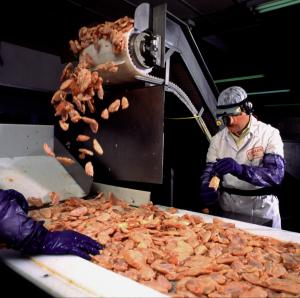US research claims more efficient turkey feed

Americans eat 5.6 billion pounds of turkey each year, and all those Thanksgiving meals and other turkey dinners add up to a mountain of feed for fattening out those birds.
Research from the University of Missouri will help producers feed those turkeys for less, saving the industry millions of dollars.
“The turkey industry feeds about $2 billion of turkey feed each year. There’s potential for almost $100 million in savings annually,” said Jeff Firman, an MU Extension poultry scientist. Those savings he suggests can come from the Missouri Ideal Turkey Protein diet, a formula based on the exact nutrient requirements of turkeys.
“Feed right now costs about $350 per ton, and you’d save about $30 per ton,” Firman said. “That’s pretty significant when most guys would be happy to save a couple dollars per ton.”
This diet shaves about 8% off feed costs compared to a standard industry diet thanks to nearly 20 years of research. Firman – an animal science professor with the MU College of Agriculture, Food and Natural Resources – is one of the few researchers nationwide who continues to tweak feed ingredients to the hundredth of a percent to eke out additional profits.
“Turkey feed is about 70% the cost of production and consists primarily of soybean meal, corn and distillers grain,” he said. “It hasn’t really changed that much over the years. What we’ve done is gotten a better idea of what those amino acid requirements are to reduce overfeeding and bring the costs down by not wasting nutrients.”
Turkey feed balances amino acids like lysine for muscle growth, minerals like magnesium and complex vitamins like choline. Those are just some of more than 40 different ingredients mixed together to make the little brown pellets fed to the birds.
“We use a computer formulation program to adjust the amino acids, which lets us input detailed nutrient requirements and adjust that formula based on the cost of the ingredients relative to those nutrients,” Firman said.
In 2010, the US turkey industry raised 244 million birds, producing more than $4 billion in economic output, according to the US Department of Agriculture. Nearly 88% of people polled by the National Turkey Federation reported eating turkey at Thanksgiving.
Large turkey producers can raise millions of turkeys in a year, so just a few cents of savings on feed per bird can add up.
“A typical tom turkey will be marketed at 40-45 pounds,” Firman said. “It would take 110 pounds of feed to get that bird to market weight, so one ton of feed will only feed 15 turkeys. The profit margins are very small for turkeys, so anything you do to cut a little off the feed cost will really help.”
Details about the Missouri Ideal Turkey Protein diet can be found here.












